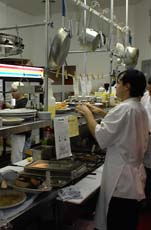|
Jeff
Tendick’s gentle, “happy to be here” style must be
contagious, because the whole crew at the Depot seems tickled to
be serving an intriguing menu of what Tendick calls “French,
general European and some Midwestern fare.” Server Melissa Habisohn, an LCC senior from Crystal Lake, can
barely contain her delight at mouthing the words, “La Boule
Boeuf Bourguignon,” and assistant server Michael Berkshire is
quick to assure diners that Chef Jeff’s special creation of
fresh beef tips, whole mushrooms, sliced carrots, aromatic herbs,
garlic and a hint of turnip, flavored with brandy and Burgundy
wine in a hollowed bowl of freshly-baked French bread is manna
from heaven.

Manager
Dan Knuppel beams with pride as Chef Jeff and his kitchen staff
present to the polished servers colorful and hearty dishes, from
16-ounce New York strip steaks to dainty cheesecakes laced with rosy
raspberry puree and drizzled with chocolate.
Assistant server Sharon Wilson, a Chicagoan from Hyde Park,
pours water and fills coffee cups with a careful grace.
Her thin yellow tie is just the right touch of foreground
against a crisp, white shirt. Server
Melanie Goforth, a Lincoln native with restaurant experience in
Naples, Fla., says The Restaurant at the Depot makes her proud of
her hometown.

[Chef Jeff's kitchen crew prepares
a variety of colorful and tasty meals.]
Now
back to the food. Even
the entrees shout “happy to be here.”
“Roast Pork Gentleman Jack,” “Chicken Tarragon,”
“Cotes de Porc du Roi” and “Catfish Supreme.”
That last one is evidence of the Midwestern favorites that
Chef Jeff has cordially added to the mix.

|

If
the European cuisine is a bit foreign to you (oh, come on, give it a
try), then order up some Railsplitter fries with two Wisconsin brats
on grilled sourdough bread, add some sauerkraut and melted Swiss
cheese, and tell the bartender to pour you a Leinenkugel Red.
Then you, too, will be happy to be here.
Some
dishes are served with bread topped with Chef Jeff’s Calamata
butter, black with ground olives in an olive oil base and a touch
of something only the Chef can name.
The house bread is a soft, even-textured, sweet French
sub-roll, light with golden folds.

[Mark and Debra Howard (left) chat with Mike and
Debbie Kilgallen in the sun room.]
Happy
diners are unhurried; they chat around comfortably-spaced,
linen-bedecked tables in the elegant Victorian room, and watch
Lincoln’s downtown fade from twilight to nightfall through the
atrium of the sun room. Something
old and good has returned to Lincoln, leisurely dining in a lovely
place that holds many memories—the Depot.

[Chef Jeff is happy to be in Lincoln.]
With
the re-opening of the Depot, one suspects that Lincoln itself is
opening to a happy era. A
spate of other good restaurants have come to Lincoln in the past
few years, and several of the old standbys have expanded,
freshened up and kept pace with a generation that, like none
before it, enjoys eating out. Good restaurants in Lincoln don’t
compete with each other so much as they give us all reason to stay
in town, frequent them all, and count our blessings.
Click
here
to view more images of LDN's night at the Depot.
[LDN]
|

